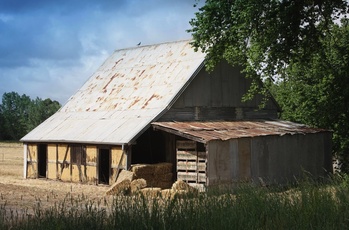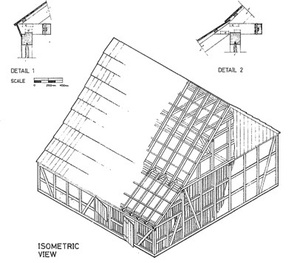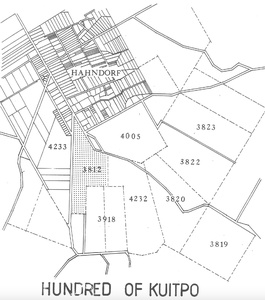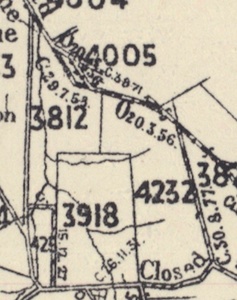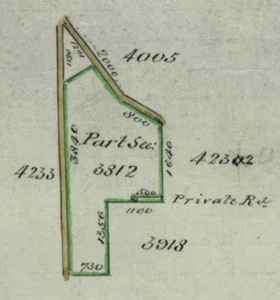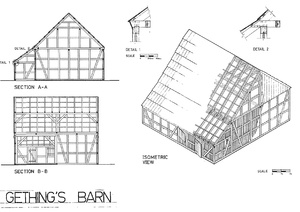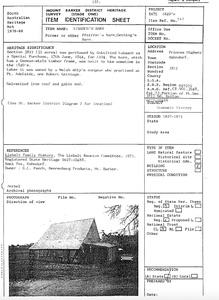This Page forms part of the overall Zebra-ProjectBy clicking on the following Link a list of all Zebra-Project tabbed pages will be displayed. |
|
Lothar BRASSE Beerenberg BarnBarn built for Gottfried LUBASCH & familyArchitecture, conservation works & previous owners.I acknowledge the care and sensitivity taken by the PAECH family over many years of heritage guardianship in conserving this unique building.
Also known as GETHING's Barn, HOFFMANN'S place, PAECH's barn, PFEIFFER's old barn |
Summary
This article looks at the
- conservation management by Lothar BRASSE
-
names given by the local Hahndorf community to describe 'Beerenberg Barn' in the past & then provides family history information regarding those owners.
-
the descriptions & sketches, heritage surveys have provided about the barn
Family names mentioned in this article:
ALLEN, BEALE, BEATTIED, BRASSE, BRIDGMAN, BLAIR, BLUNDELL, BUTLER, BURGE, CAVE, CHAMBERS, CLEAVE, COUNSELL, DEMPSTER, DOWNER, DOYLE, DUNCAN, FERGUSON, FORMBY, FLETCHER, GETHING, GREEN, GOWER, HADDY, HARMSTOF, HALLACK, HANNAY, HAWKINS, HENDERSON, HIGNETT, HODGE, HOFFMAN, HUZLEY, HUXLEY, KESTEL, KING, LEVI, LUBASCH, MALIN, MARSDEN, MEAD, MUECKE, MURRAY, OWEN, PAECH, PFEIFFER, RANN, RENNER, ROSE, ROSS, SEABROOK, SMITH, SCOTT, TOLL, THOMPSON, TOMSETT, POLVERE. WEDD, WEMAN, YOUNG,
Table of Contents
GETHING family
1. 1882 GETHING family section 3812 & call their farm 'St Julian's'
- Reg BUTLER sketches the position of 'St Julian's'
2. 1883 Certificate of Title 399/137
3. Authors Note
4. The South Australian Register, 1883, Obituary
5. The South Australian Advertiser, 1883, Obituary
6. South Australian Weekly Chronicle, 1883
8. Critic, 1900
9. The South Australian Register, 1900
10. 1883 Certificate of Title 399/137
HOFFMANN family
12. 1961 HOFFMANN family section 3812, known as 'HOFFMANN's place'.
13. 1981 Hahndorf Survey Volume 1
14. 1983 Mount Barker District Heritage Survey,
1. 'Beerenberg German Barn Conservation and Management Plan' by Lothar BRASSE 2004
'This report is part of a conservation strategy adopted by Heritage SA in May 2003 through Luigi Vitali and Duncan Ross-Watt.'
Photographic Record of existing condition March 2003.
| 1 | 2 | 3 |
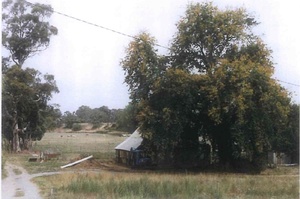 |
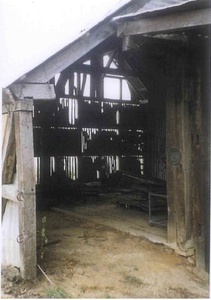 |
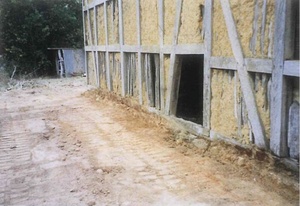 |
| 4 | 5 | 6 |
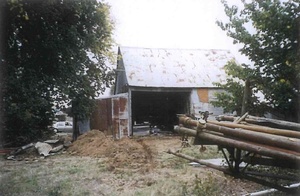 |
 |
 |
| 7 | 8 | 9 |
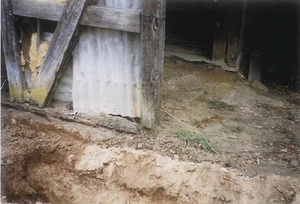 |
 |
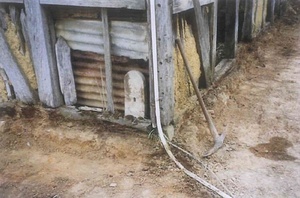 |
| 10 | 11 | 12 |
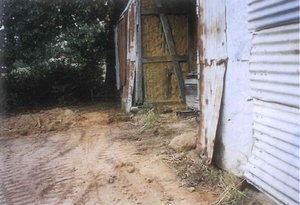 |
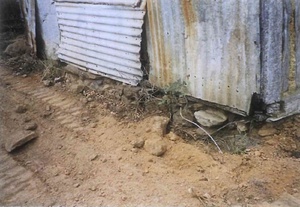 |
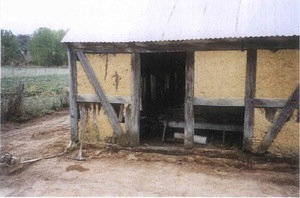 |
| Photographic record of conservation works carried out March 2004 | ||
| 13 | 14 | 15 |
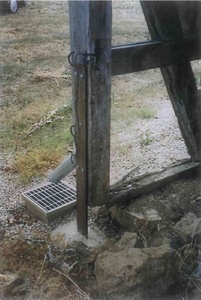 |
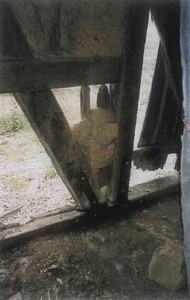 |
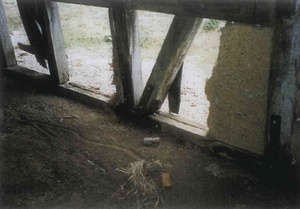 |
| 16 | 17 | 18 |
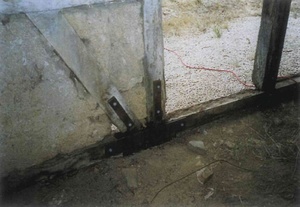 |
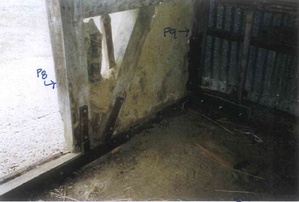 |
 |
| 19 | 20 | 21 |
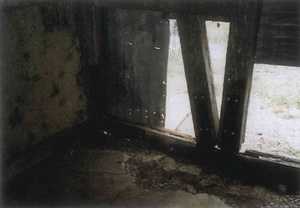 |
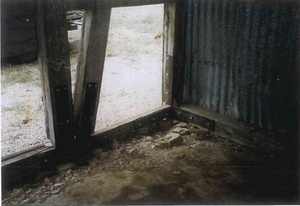 |
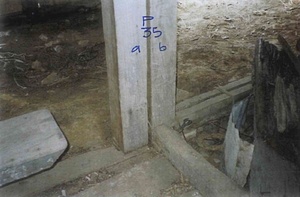 |
| 22 | 23 | 24 |
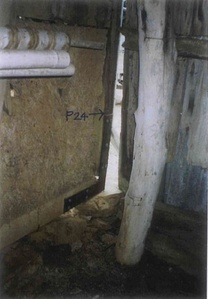 |
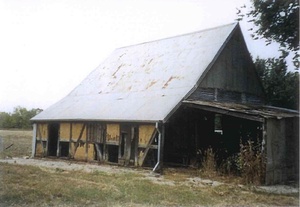 |
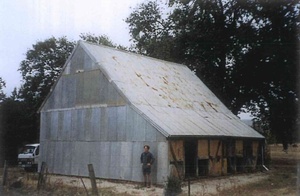 |
Physical Analysis
Description of the Barn
- The plan is square, measuring approx 9.3 x 9.3m and it is divided into three main areas:
- An entrance bay at the north-east end
- A southern storage area
- A 2.3m wide lean-to along the eastern length.
- It is likely that a mezzanine floor was above the southern area.
- Main entry was via a large double door - similar to the one at Ravenswood see opposite with a small personal one on the opposite lean-to side.
- Footings: Stone walls below all timber wall plates
- Floor: Red gum boards approx 285x65 laid on course sand and dowelled to bearers at approximately 1000cc also bedded on course sand. There was no subfloor ventilation.
- Walls: Typical half-timbered with a top and bottom plates, posts, braces and intermediate horizontal rails. Panels were filled with wattle and daub, onto vertical staves. Later brick and stones were inserted to selected areas.
- Roof: Collar tie and beamed truss system. Corrugated iron has replaced the original timber shingles.
Condition
The Barn has suffered from years of neglect, the main concerns being:
Numerous main structural members have been removed.
These have been identified and noted on the drawings accompany this report.
Pidgeon manure from the dozens of birds that have made the barn their home.
This has also resulted n attracting other vermin now cohabitating with the spaces.
Erosion of original daubing, resulting in build up of mud at the base, in some cases covering the base plates.
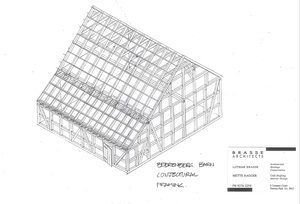 |
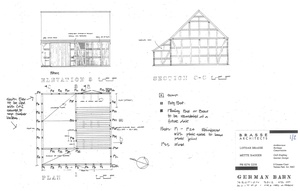 |
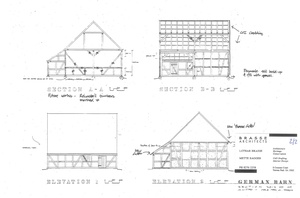 |
2. Robert GETHING purchases 49 acres of Section 3812.
The GETHING family live in Port Adelaide where Robert works as a doctor, in 1860 he married Jane TOLL at Blakiston & twenty two years later in August 1882 they purchase acreage close to Hahndorf, described below by Reg BUTLER as a 'gentleman's farm'. All of their 6 children have been born in Port Adelaide, although as stated below they also went to school at the Hahndorf College prior to the purchase of the property. Robert & Jane married on 29 December 1860 at St James Blakiston Church, where Robert is now buried.
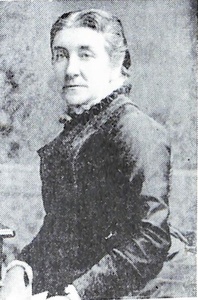 Jane Trevanion TOLL d 15 March 1908 aged 77 years. Jane Trevanion TOLL d 15 March 1908 aged 77 years. |
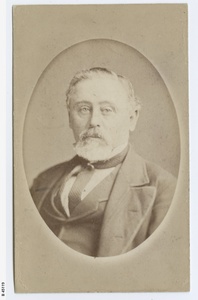 SLSA B-45119. 1826-1883 SLSA B-45119. 1826-1883 |
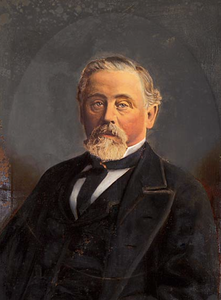 |
State Library of S.A. "Fifty years of the Port Adelaide Institute" 'Doctor Robert GETHING was a health and medical officer who began his practice in Port Adelaide in 1854." and 'Dr GETHING was born c1826 and arrived in Port Adelaide on the 'Raleigh' in 1851. He was appointed Government Medical Officer i1878 in succession to Dr H. DUNCAN.'
The History of South Australia by Edwin HODDER 1893.
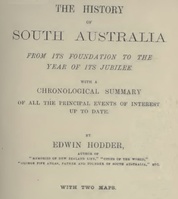 Cover page A
Cover page A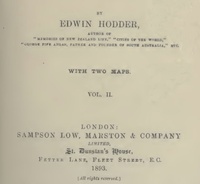 Cover page B. 'E HODDER, 1893'
Cover page B. 'E HODDER, 1893'
1893 Obituaries. 'October 21 - Dr Robert Gething, Health Officer at Port Adelaide. Thirty three years in the colony.
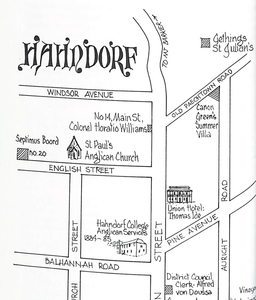 Reg BUTLER 'In an Essentially German Village' page 23
Reg BUTLER 'In an Essentially German Village' page 23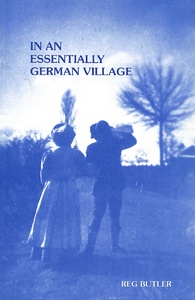 'In an essentially German Village' Reg BUTLER
'In an essentially German Village' Reg BUTLER
'Further along, at the junction of Hahndorf's main road with the old road to Paechtown was Saint Julian's, the gentleman's farm of Port Adelaide's beloved doctor, Robert GETHING, whose wife was a local girl, the daughter of Nairne's miller, John TOLL, who earned a memorial in St James's , Blakiston, for suffering fatal injuries when his trap capsized after morning service in March 1864.
It was a great blow for Hahndorf's Anglican cause when Doctor GETHING died suddenly in 1883, but his widow and unmarried daughters continued living at Hahndorf for many years.
On the other corner of the Paechtown intersection was the summer villa of Canon Samuel GREEN, of St Paul's Port Adelaide. Perhaps the GETHINGS enticed him to resort to Hahndorf, as they were his parishioners at the Port.'
3. 1883 Certificate of Title 399/137, 49 acres, a portion of Section 3812
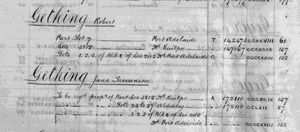 SAILIS 1881-1884 page 39 SAILIS 1881-1884 page 39 |
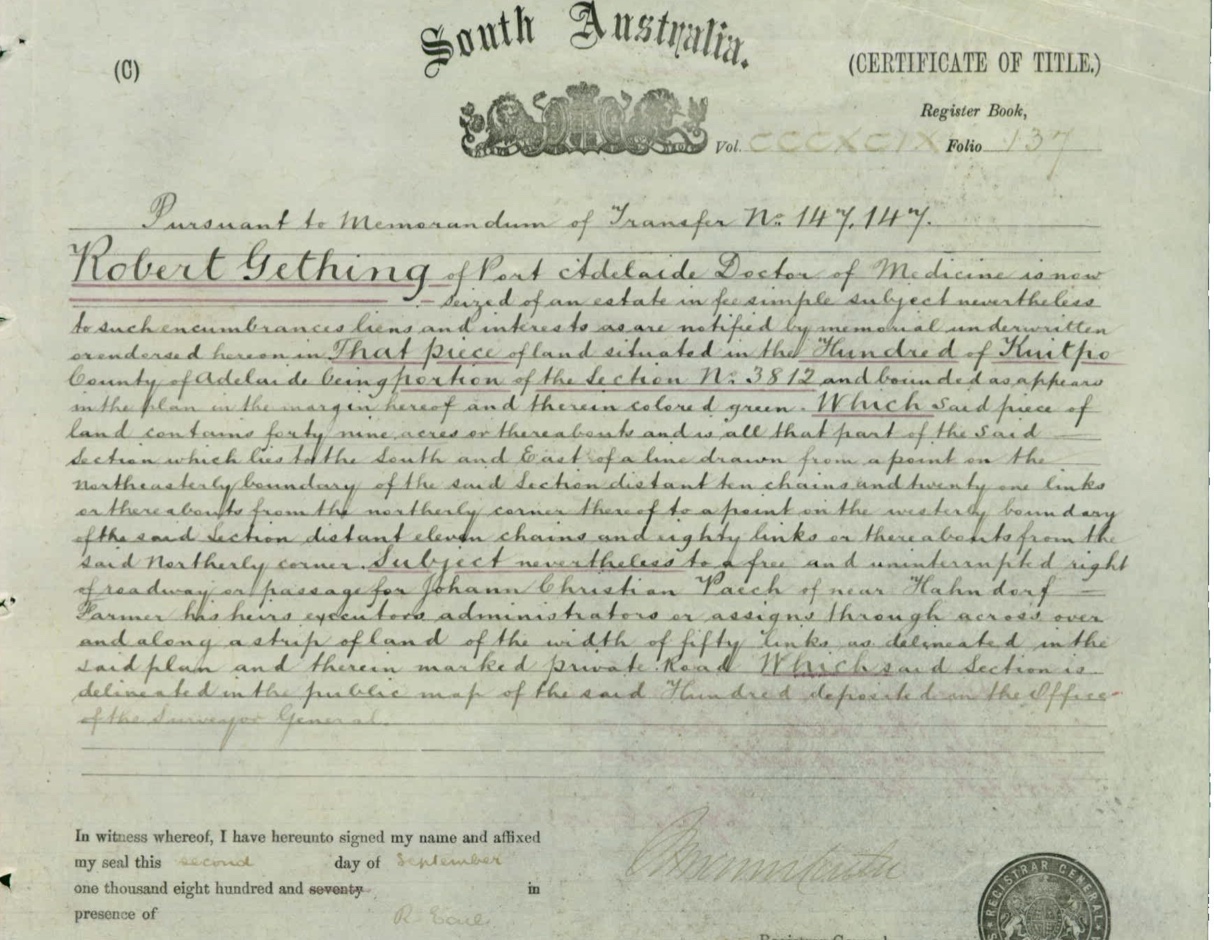 1870 SAILIS CT Vol 399 Folio 137 1870 SAILIS CT Vol 399 Folio 137 |
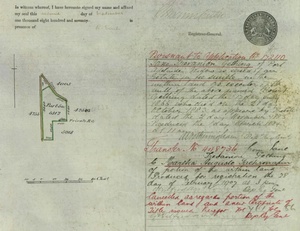 1870 SAILIS CT Vol 399 Folio 137 1870 SAILIS CT Vol 399 Folio 137 |
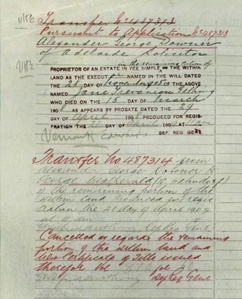 1870 SAILIS CT Vol 399 Folio 137 1870 SAILIS CT Vol 399 Folio 137 |
'Robert GETHING of Port Adelaide Doctor of Medicine is now .... Hundred of Kuitpo, County of Adelaide portion of the Section 3812, 49 acres.....subject to a free and uninterrupted right of roadway or passage for Johann Christian PAECH of near Hahndorf, Farmer, his heirs executors administrators or assigns through across over and along a strip of land of the width of fifty links as delineated in the said plan and therein marked private road.... 2 September 1870.
4. Authors Note:
Dr. Robert GETHING died in October 1883, just over a year since his purchase of 49 acres, section 3812. Reg BUTLER & other sources [below] indicate that his wife, Jane TOLL continued to live at 'St Julian's' until around 1900, with their four unmarried daughters.
Note the position of 'St Julian's, on the right, in the triangular area that formed section 3812. 'Old Paechtown Road' to the south of the property is now called Auricht Road. This is an important observation because the position of the farm house, 'St Julian's, almost certainly links with the house, currently just meters away from the 'Beerenberg Barn' that is often referred to as 'Hoffman's Place'. I believe this is one and the same building. See..... for more evidence of this.
- The following SAGHS 'Birth Registrations' Database provides the date and place of birth of all of their 6 children.
-
William John b8 September 1862 at Port Adelaide,
-
Robert Walter James b19 October 1864 Port Adelaide,
-
Kate Charlotte b14 March 1866 Port Adelaide.
-
Clara Jane b22 August 1867 Port Adelaide.
-
Grace Ellen b9 December 1868, Port Adelaide.
-
Augusta Mary b26 August 1870, St Vincent St, Port Adelaide.
In 'Our Townships, Farms & Homesteads', Adelaide 1892 by E.H. HALLACK says : 'Further on is seen Mrs GETHING's residence, and its selection does credit to the memory of the well-known and much respected former medico of Pt Adelaide.'
Jane GETHING died 1908, and she is said to have left Hahndorf 7-8 years prior to her death. Since her husband died in 1883 & Jane in 1908, she lived at 'St Julian's' until 1900 approximately, which was a period of 17 years.
-
Above Reg BUTLER writes , 'but his widow and unmarried daughters continued living at Hahndorf for many years.'
- Grace Ellen GETHING noted in the paper her approaching marriage 'announced in April 1900 while residing at St Julians, Hahndorf'.
-
In 1883 when Robert GETHING died his children were aged: William John 21, Robert Walter James 19, Kate Charlotte 17, Clara Jane 16, Grace Ellen 15 and Augusta Mary, 13 years.
-
It appears that once the youngest daughters married in 1900 & 1901, Jane TOLL moved back to the city where she died at her place of residence in Croydon, Hindmarsh in March 1908 aged 77 years.
- William John married Gertrude ROSE in June 1900
- Walter Robert James married Catherine CHAMBERS in 1899
- Charlotte Kate never married and died at 69 years of age at Kensington Gardens in March 1936
- Clara Jane married Frank William John BLUNDELL in December 1898,
- Grace Ellen married Charles Percy ALLEN in April 1900
- Augusta Mary married James SCOTT in March 1901,
-
It appears that once the youngest daughters married in 1900 & 1901, Jane TOLL moved back to the city where she died at her place of residence in Croydon, Hindmarsh in March 1908 aged 77 years.
- Reg BUTLER states in 'A College in the Wattles' page 322 that 'Walter Robert James GETHING' studied at the Hahndorf College 'from 1874-1877', when he was 12-15 years of age, & then went to Prince Alfred College in 1877. He also says eldest son 'William John GETHING' studied at the College from 1873-1877 but had attended Port Adelaide Grammar School earlier and then also went onto Prince Alfred College in 1877. Since Robert GETHING did not purchase section 3812 until 1882 it might have been that his sons were boarders in Hahndorf commuting from their home in Port Adelaide.
- Jane GETHINGS brother, Dr John Tresillian TOLL was returning from the Boer War when he died, [see below] and he was a partner in her husbands medical practice at Port Adelaide. This is another confirmation that Jane GETHINGS main residence was St Julians, on section 3812 in 1900.
See https://en.wikisource.org/wiki/Notable_South_Australians/Dr._Robert_Gething
https://en.wikisource.org/wiki/Page:Notable_South_Australians.djvu/163
https://www.samhs.org.au/Virtual%20Museum/hospital-andother-orgs/PortAdelCasHosp/pachsp.html
5. The South Australian Register [Adelaide, SA:1839-1900] Saturday, 27 October 1883, Page 2, Obituary.
'Death of Dr. GETHING. We regret to announce the sudden death of Dr. Robert GETHING, of Port Adelaide, at 7 o'clock on Sunday morning, October 21. The deceased gentleman had been suffering some time from a heart complaint, but was seized on Saturday night with what his medical attendants pronounced to be an apoplectic fit, and remained insensible till he expired. Dr GETHING, whose energetic and impulsive ways tamped him with a special individuality, and whose general and generous temper, together with a hospitable and charitable habit, endeared him to many people, arrived in this colony in 1850 in charge of the immigrant ship 'Raleigh' and at once settled to the practice of his profession at Port Adelaide, with whose subsequent history he has been closely connected.
the young doctor, who was born at Usk, in Wales, in 1826, came here full of honours, having graduated as M.D. at Edinburgh, and being a member of the Royal College of Surgeons in England, and licentiate of the Apothecaries Society, London. Amongst his college friends were men who have since become eminent, as Mr Justice HAWKINS, Professor HUZLEY, and others. During his residence in the Port of over a generation he earned the confidence and respect of all classes, and in company was a host in himself, being a well-read gentleman, with great sense of humour and keen observation. He was practically in harness to the last, having but recently obtained a month's leave of absence from the Government, whose Health Officer he has been since Dr. DUNCAN died in 1878. he went with Mr. J.E. DEMPSTER, J.P. to Hahndorf to try the effect of a change of air, and was as hearty as possible till the fatal attack seized him. Drs WELD, and RENNER attended him, and Drs TOLL [his partner & his wife's brother] and SEABROOK followed in the morning. The two latter gentlemen arrived shortly after death. Dr GETHING's age was fifty-seven years. He leaves a widow and family, towards whom in their bereavement there will be numerous expressions of sympathy, not only in Port Adelaide, but in many other places. On Monday morning, at Port Adelaide, the respected felt for the memory of the late Dr GETHING showed itself in flags flying a half mast, and in the shutters of the principal shops being left up. The funeral took place at Blakiston on Tuesday. The Rev. J. W. GOWER conducted the services, and the Church at the cemetery was crowded. In addition to a large number of person from the city and Port Adelaide the lads of Hahndorf College joined in the procession, which was very lengthy.'
6. The South Australian Advertiser [Adelaide, SA:1858-1889] Monday 22 October 1883, Page 6, Death of Dr. GETHING.
'A general feeling of regret was experienced at Port Adelaide, on Sunday afternoon, October 21, when it became known that Dr GETHING had died at Hahndorf on that morning. The sad event was almost altogether unexpected. The doctor had apparently been in his usual health during the last few days, and indeed for weeks, and when he left Port Adelaide on Saturday afternoon on one of his periodical visits to Hahndorf no one for a moment supposed that he was never to see the old and welcome face again. The doctor was accompanied to Hahndorf by Mrs GETHING, several of his children, and Mr J.E. DEMPSTER and seemed to be in his usual health and cheerful spirits. But at about 11 o'clock in the evening, before retiring to rest, he was seized, without any warning, with an attack of apoplexy, and remained unconscious until his death, which took place a few minutes before 7 o'clock next morning. The local medical men, Drs. WELD and RENNER, were in attendance, and Dr. TOLL, his brother in law, was telegraphed for from the Port. The latter, however, with Dr. S. SEABROOKE who accompanied him was unable to reach Hahndorf until all was over. Although the unfortunate occurrence was so sudden, yet to those who knew the deceased gentleman intimately, it was not a very great surprise. He had on previous occasions been laid aside form his duties for short periods, and he had expressed his belief that his end would be sudden, and be earned by the malady to which he succumbed. This knowledge, acquired from his professional skill, caused him no uneasiness, so far as could be seen from his ever pleasant and genial manner.
It must, however, have crossed his mind, for "it is a most singular circumstance," says our shipping reporter, "that on Friday night he visited the Semaphore station, and on leaving took a more than usually affectionate farewell of his assistant, remarking as he did so that he might never see him again. Dr GETHING was born at Use in Wales in 1826 and graduated at Edinburgh, becoming M.R.C.S., and taking the degree of M.D. He had for his teachers two or three of the most remarkable men of the century in anatomy and physiology, including Professor Richard OWEN, and amongst his fellow-students were HUXLEY and BEALE. Having obtained high honours at the comparatively early age of 23 years, he was compelled in consequence of weak health to leave England, and deciding upon South Australia as his abode because of its climate he came out here early in 1850 in the ship 'Raleigh', of which he was one of the surgeons, and settled in Port Adelaide. His and and most engaging manner soon secured him many friends, and his medical skill enabled him quickly to obtain a good practice, which he never afterwards lost. It is needless and, indeed, it would be impossible to relate the many good deeds or to call special attention to the valuable qualities which endeared Dr. GETHING to all classes at Port Adelaide. Assisted by a devoted wife, his whole life there was spent in doing good. If there was a family in poor circumstance, if any unfortunate man, woman or child was disabled by accident or disease, he was always ready to lend a helping hand. His professional services were at the call of everyone, and in rendering them he showed no favour to either rich or poor. He never passed a needy man or woman for fees, and probably it would be no exaggeration to state that he was not paid more than half of his services. Hundreds of pounds have been raised and subscribed by his wife and himself in special cases, and it was only necessary for the charitably disposed to know that Dr GETHING favoured any object to ensure its success. Except, however, in the case of public subscriptions, his good deeds were not noised abroad and were known only to the few whose calling or chance brought them into contact with the poorer classes. It is safe to say that a harsh or unkind word was ever said at Port Adelaide of Dr GETHING, by those who's opinion was worth aught, and it is quite certain that no man ever lived there who was store generally respected and like, or whose friendship was better esteemed.
When in 1878 Dr GETHING was appointed health officer in succession to Dr. DUNCAN, it was everywhere felt that an excellent choice had been made, and there is no need to refer to his successful though unfortunately short career in that capacity. The admirable way in which he inaugurated and carried out the Torrens Island quarantine scheme, assisted by Dr. TOLL, called forth the flattering comments of authorities both in Great Britain and the other colonies, special reference having been made to him in official reports. Dr. GETHING was an enthusiast in his profession. He kept himself well apace with the times in every department of it, being an especial expert on germ diseases. The knowledge he posses upon subjects kindred to his profession was also exceedingly thorough and varied, but it was only with a privileged few of his friends the he would debate them. He took great interest in the evolution theory, and probably possessed the finest collection of works upon the subject in the colony, all of which he had mastered. He generally favoured the views of DARWIN and HAECKEL as to the process of evolution, but scouted the theory of the latter as to spontaneous generation. In discussing the subject with friends he would sometimes surprise them by his brilliancy in dealing with disputed points, and not infrequently showed an originality of idea, which had he possessed the time to work out, might have made him known at home as well as here.
He had also been a deep metaphysical student. The doctor never took an active part in public matters at Port Adelaide, though he always allowed it to be known which way his sympathies were upon any subject. The deceased gentleman leaves a wife and several children who will be very deeply sympathised with in their bereavement. In his charitable acts the doctor was always associated with his wife, and by those whom they helped the two were looked upon as one kind assistant. The remains of the deceased gentleman will be interred in the churchyard at Blakiston on Tuesday afternoon.
7. South Australian Weekly Chronicle [Adelaide, SA: 1881-1889] Saturday 27 October 1883, Page 7 General News
...........'The remains of the late Dr. Robert GETHING were interred in Blakiston churchyard on Tuesday afternoon, October 23. I twas intended that the funeral should be conducted as privately as possible, in accordance with the wishes of the deceased, but her had so many friends, and was so much esteemed, that it was not surprising a considerable number were unable to resist the opportunity of offering the final tribute of respect to his memory, The majority of those who joined the cortege went from Port Adelaide. The members of the Port Town Council attended in a body, and very few of the local officials, professional men and principal tradesmen were absent. The vehicles, in all some thirty or forty in number, assembled at the late doctor's residence at Hahndorf early in the afternoon, and proceeded to Blakiston, a small village some five miles distant. As the cortege wound its way around the hills the effect was very solemn and striking. Nothing could be heard save the grating of the wheels and brakes, and the occasional rusting of the trees. to the eye only majestic hills covered with scrub and a long winding road with the black file of carriages were visible, and it seemed peculiarly appropriate that a man had earned the gratitude, sympathy, and affection of a whole town should be followed to his last resting-place by his fellow citizens under such impressive surroundings. On arrival at Blakiston a short preliminary service was held in the church, which was crowded, and the coffin was then carried out to a grave in the churchyard close to the spot where some of Dr GETHING's relatives live buried. The Rev. J.W. GOWER conducted the services in the church and at the grave, and it need hardly be said the the whole proceedings were most solemn and impressive. Amongst those present [there were over 200 altogether], besides the relatives of the deceased, were - The Mayor of Port Adelaide, Councillors CLEAVE, HADDY, BEATTIED, MALIN, BRIDGMAN, KESTEL, and RANN; the town clerk, the overseer, and the inspector; Captain R.H. FERGUSON, Captain J.W. SMITH, Messrs, C. DOWNER, G. DOWNER, H. DOWNER, J.E. DEMPSTER, T.J. KING, J. HENDERSON, H.W. THOMPSON, H.C. MUECKE, J. FORMBY, H. FLETCHER, M. MEAD, J.B.BLAIR, W.H.ROSS, J. HANNAY, BURGE, J. COUNSELL, W. TOMSETT, H.WEMAN, J. MURRAY, A.P. LEVI, W.R. CAVE, J.G. HADDY, G.P. HODGE, Inspector DOYLE, the superintendent and assistant superintendent of the quarantine station, with a large number of medical men, and other gentlemen from Adelaide, Most of the shops at Port Adelaide were closed, and all flags were half-mastered throughout the day.'
8. Observer [Adelaide, SA: 1905-1931] Saturday 21 March 1908, Page 38, Mrs GETHING
'Mrs GETHING widow of the late Dr. GETHING of Port Adelaide, died suddenly at her residence, Croydon, on Sunday night. The deceased lady, who was 75 years of age, was born at Cornwall, and came to South Australia with her parents [Mr. and Mrs TOLL] in the early fifties. Until her husband's death Mrs GETHING resided at Port Adelaide. For some time after she lived at Hahndorf, but for the last seven or eight years she had resided at Croydon. Two sons - Dr W.J. GETHING, officer of health for the Government at Port Adelaide, and Mr W. GETHING of Kalgoorlie - and four daughters - Mesdames SCOTT and ALLEN of Croydon; Mrs BLUNDELL of Tarcoola and Miss GETHING - survive.'
9. Critic [Adelaide, SA: 1897-1924] Saturday 21 April 1900 Page 24, Approaching Marriages
'The marriage of Mr. G. ALLEN, of Staffordshire, England to Miss Grace GETHING daughter of the late S.R. GETHING & of Mrs R. GETHING, St. Julians, Hahndorf, will take place at the end of the month.'
10. The South Australian Register [Adelaide, SA:1839-1900] 5 July 1900, Page .....
Dr John Tresillian TOLL. "TOLL - On the 20 June, of apoplexy, on board the Australasian; invalided from South Africa, Surgeon-Major John TOLL, dearly beloved brother of Mrs R. GETHING, St Julians, Hahndorf, in his 50th year."
11. 'Hahndorf Sketchbook Drawings' by Anni LUUR FOX, Text by Lena L.WADE, 1976
'GETHINGs Barn'
'Several of the timber-framed barns walled with pug and roofed with thatch by the first settlers, are still in use. One such is this old barn belonging now to Grant PAECH. The land was part of the section originally owned by Sergeant LUBASCH, from which he gave five acres to each of his daughters when they married.
Authors Note: Two of his daughters inherited land from his will, they were not given it upon marriage. See.
This area was the site of the golf course until about twenty years ago, when a new one was organised in Balhannah Road. The property was owned for many years by Robert GETHINGS, a Welsh born ship's surgeon who settled at Port Adelaide. in the 1840's. Dr GETHINGS retained his practice at the Port, but probably kept the Hahndorf house as a summer residence. His son was educated at Hahndorf College.
Hay was kept in the oats of the barn, while the ground floor usually served as stables and harness shed, combined with the farm workshop. John BULL writes of the pioneers' home made wooden harrows and one-handed ploughs made form boughs of trees and pulled by a bullock or a horse, or even one bullock and one wife - the woman having over her shoulder a leather strap attached to the singletree, while her husband used his free hand to hold his pipe!
Native timbers were used for post and rail fences, though some of the German settlers brought with them seeds of the furze used for hedges in their homeland - the the regret of their descendants. Part of the carpenter's equipment brought from the old country was the Schnitzelbank - a combination workbench, vice and stool. The carpenter sat at one end and used a foot-operated clamp to hold his work.
The pig-catcher was another ingenious piece of farm-made equipment. [There is one in the museum]. Every cottager kept one or two pigs to eat the garden surplus and to turn skim milk into valuable pork, bacon, and small goods like Mettwurst, Blutwurst, and Leberwurst. No part of the pig was wasted.'
12. Stanley Lewis HOFFMANN & Eileen Eleanore MUELLER
According to Stanley & Eileen's only child Michael, they purchased this Section 3812, about 49 acres in 1960. They had several farming moves before arriving in Hahndorf, initially a vineyard at Rowland Flat & a dairy farm at Echunga. After Section 3812 was acquired by the highways department and the remaining land was sold to Grant PAECH, the HOFFMANN's went to a dairy at Jervois.
What I did not realise until I spoke with Michael in early March 2024 was that his mother Eileen was a MUELLER, and therefore a 1st cousin to Hilda MUELLER who is John MUELLER's mother. John being the reason I began this project some years ago when he shared his photographic collection with me.
When Johanne Eleanor PAECH [her parents were on the 'Zebra'] who inherited the old fachwerk house in Paechtown, from her parents [the construction work attributed to Carl FAEHRMANN] married Johann Carl Ferdinand MÜLLER in 1879 they had two sons. The younger Edward Otto b1882 was John's grandfather and the older son Wilhelm Alfred MÜLLER who married [1903] Wilhelmine Caroline Dorothea MEYER [known as Minnie] was Eileen's father.
'Alf' as her father was known had a property on the Echunga Road known as 'Green Oaks'.
All 3 photographs from the 'John MUELLER Photographic & Other Archival Materials Collection'.
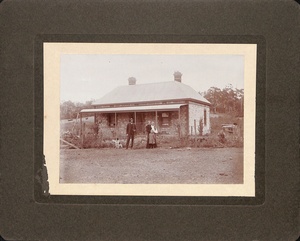
Reverse: 'W.A. MUELLER' ?? Green Oaks?? Echunga Road |
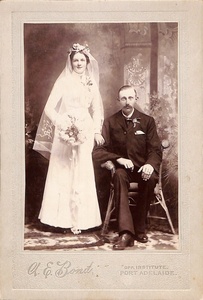 Reverse: 'Mr & Mrs W.A. MUELLER' Reverse: 'Mr & Mrs W.A. MUELLER' |
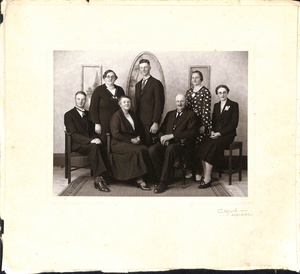 Reverse: 'W.A. MUELLER & family' Reverse: 'W.A. MUELLER & family' |
Michael tells an interesting story about how his grandparents met because while 'Alf' was farming in Paechtown, 'Minnie' was from Port Adelaide. This story also includes information about the waggon currently [2024] found in the lean-to of the barn built for the LUBASCH family by Carl FAEHRMANN. The same barn that their son in law [Stanley HOFFMANN] and grandson Michael, used as a hay shed in the 1960's.
According to Adelaide Hills Localwiki 'Kaesler Brothers was established in 1905 when Ewald and Reinhold Kaesler bought Starick and Wiese's Coach-building and Blacksmithing business'. According to Michael the MEYER family of Port Adelaide were friendly with the WIESE coach building family and as his grandmother was a regular visitor to Hahndorf she met her husband to be while visiting the village. Michael then says that the WIESE family built them a German waggon, which they could put together for their customers in 18 hours of hard labour. This waggon worked on the 'Green Oaks' property and Michael says that this is the waggon that was purchased by Grant & Carol PAECH and is stored at Beerenberg Farm.
SAGHS 'Births Database'
-
Parents: Johann Gottlieb HOFFMANN & Franziska Louisa FROMM
- Herbert Howard born New Mecklenburg, Barossa, 6 April 1911.
- Richard Heinrich born New Mecklenburg, Barossa, 16 June 1912.
- Leslie George born New Mecklenberg, Barossa, 19 January 1914.
- Minna Louise born New Mecklenburg, Barossa, 23 October 1915.
- Emily Hulda born New Mecklenburg, Barossa, 2 September 1917.
- Stanley Lewis born at Gomersal, Barossa, 21 February 1919 died at 51 years of age 1 February 1971, Mt Barker, Hahndorf.
- Olga Nita born Gomersal, Barossa, 30 August 1920.
- Benno Ewald born Gomersal, Barossa, 3 December 1922.
- Arthur Theodor born Gomersal, Barossa, 2 July 1924.
Husband of Eileen father of Michael, buried Hahndorf General Cemetery
13. 1981 Hahndorf Survey 'GETHING's Barn'
Handorf Survey, Vol 1 by G.YOUNG, I.HARMSTORF, L. BRASSE, A. MARSDEN, Page 198 'Gething's & the Paechtown barns'
'The two barns at Paechtown are remarkably similar. Their main halls are each 11 x 6m, in size and within this area are equal aisles of 6 x 2.7m. Only the widths of the lean-to's vary [1.7m and 2.3m]. The main doors are located centrally on the larger sides and are matched by smaller doors on the opposite wall of the lean-to. This helped to facilitate a strong draught of air for threshing the grain. The Gething's Barn is different in form but it still has a main hall 9.3 m x 7.7 m and a lean-to 2.2 m wide. There are large double doorson the ends of the barn similar in size to the ones on the other barns and a corresponding smaller door at the opposite end. All three barns have boarded floor areas in between these two doors on which threshing and bagging could take place. The timber frames have varying bay widths in each barn. Some standard sizes occur throughout; for example end bays are usually 1.3m or 1.4m. The framework to the main halls are divided into three bays vertically and all of the end bays are provided with gable braces. Standard post sizes are found in all the buildings. 150 mm2 for the corner posts and 120 x 150mm for centre posts. Similar sizes to the latter are used for the cross rails which are stub tenoned and pegged into the posts. 120 x 120mm base plates into which all the posts are stub tenoned are set level on stone walling or over large red-gum piers.
Hahndorf Survey Volume 1 page 199 & 200
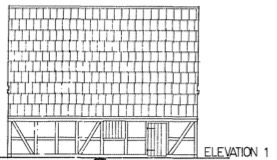 |
 |
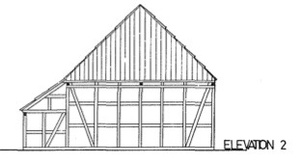 |
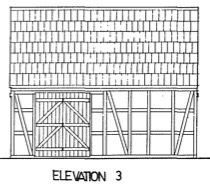 |
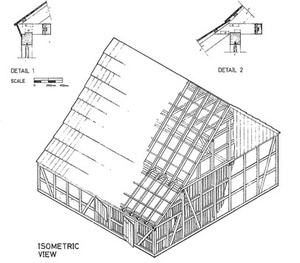 |
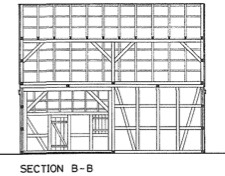 |
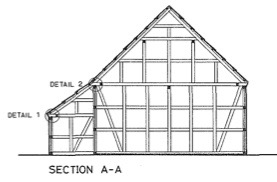 |
14. 1983 Heritage Survey ''LUBASCH's Barn'.
'Mount Barker District Heritage Survey, Stage 1, November 1983'.
Former or other Names: 'PFEIFFER's Barn, GETHINGS' Barn'.
'Section 3812 [52 acres] was purchased by Gottfried LUBASCH as a Special Purchase, 17 June, 1844 for 104 pound. The Barn, which has a German-style timber frame, was built by him sometime in the 1840's. Later it was owned by a Welsh Ship's surgeon who practised at Pt Adelaide, one Robert GETHING'.. Galvanised iron roof and gable end.'
References: 1. Liebelt Family History, The Liebelt Reunion Committee, 1975. 2. Registered State Heritage 6627-10488. 3. Anni Fox, Hahndorf. 4. Owner G.I. PAECH, Beerenberg Products, Mt Barker.
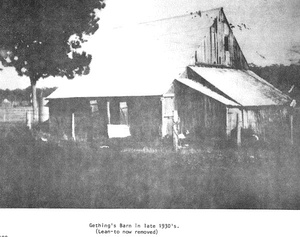 https://data.environment.sa.gov.au/Content/heritage-surveys/2-Hahndorf-Vol-1-1981.pdf
https://data.environment.sa.gov.au/Content/heritage-surveys/2-Hahndorf-Vol-1-1981.pdf

